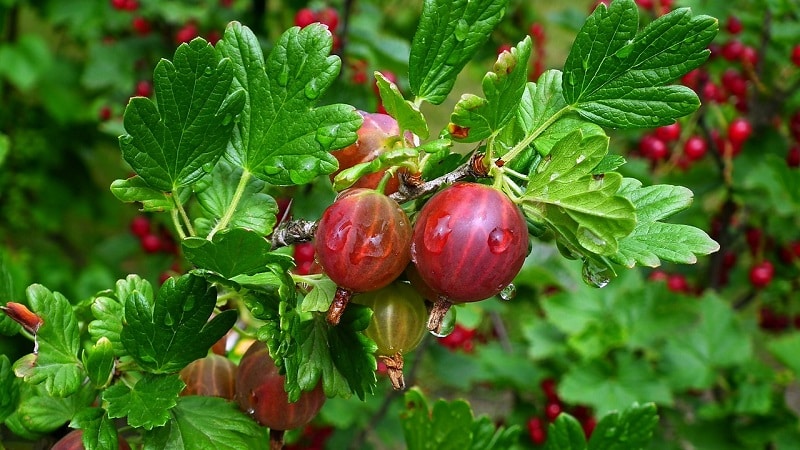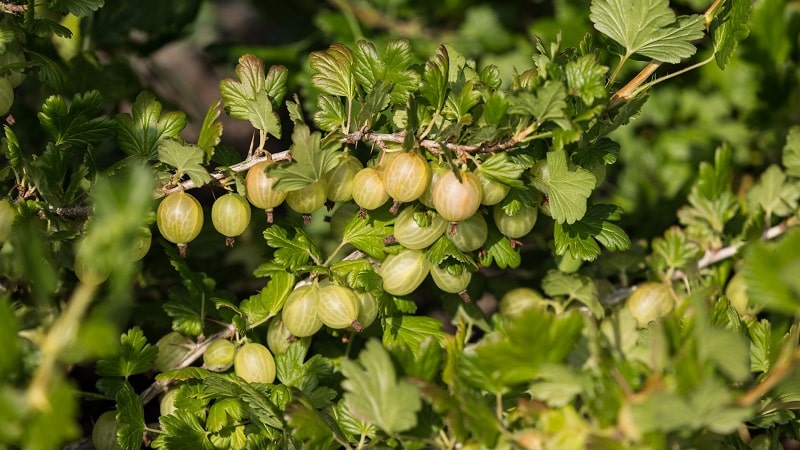Gooseberry fruit - description and characteristics
Gooseberries delight with an abundant harvest of aromatic and tasty berries, from which jams, jams, and compotes are usually made. In Western European countries, gooseberry fruits have found wider use in cooking. For example, in England they love wine made from berries, and in France they are used to prepare sauces, soups, syrups, and side dishes for game.
To get a harvest for such delicacies, you should pay close attention to planting and caring for the plant, and also study some of the nuances of its development. In the article we will look at what year after planting the gooseberry bears fruit, the life expectancy of the shrub, as well as its yield.
Botanical description of the gooseberry fruit
Gooseberry is a shrubby fruit plant, which is widely grown in garden plots. It often runs wild and spreads in forests.
Reference. Interesting names of the crop in different countries - fatty, northern grapes, goose berry.
The gooseberry fruit has different characteristics depending on the plant variety.:
- The shape is oval, round, almost spherical.
- Color green, yellow, red, violet (to almost black).
- The surface of the berry is smooth or pubescent. The veins are clearly visible.
- Weight from 2 g (for small-fruited varieties) to 20 g (for large-fruited varieties).
- Length up to 12 mm; large-fruited varieties have berries of 30-40 mm.
- The taste is sweet, sweet and sour, sweet and sour. Depending on the variety, the taste may include notes of honey (Green Rain), notes of black currant (African).

The plant blooms in May. The fruits ripen in 2-2.5 months - in July-August.
The berries ripen simultaneously, but the harvest can be harvested within a month. The fruits do not fall off, even when they reach biological maturity.
For what year after planting do gooseberries bear fruit?
Time frames, when gooseberries begin to bear fruit depends on several factors:
- plant varieties, for example, the beginning of fruiting of American and hybrid thornless varieties (Northern Captain, Malachite, African) occurs as early as possible - already in the second year after planting the seedlings;
- growing conditions (climate, soil, lighting);
- care (proper planting, pruning, feeding the plant);
- situational weather conditions (drought, frost).
If we take the average value, then the bush begins to produce berries 3-4 years after planting. The fruiting period with high yield begins in the 6-8th year of the plant’s life.
How many years does a gooseberry live and bear fruit?
How long does a gooseberry live? depends on growing conditions and compliance with agricultural technology. With a favorable climate, good soil, and proper care, the life expectancy of the plant is about 30 years.
In this regard, an important role is played pruning old black branches at the root of the bush, starting from the age of 7. Old branches are replaced with new shoots, resulting in plant rejuvenation.
The bush bears fruit throughout its life. However, good productivity remains up to 15-20 years, after which it gradually decreases.
Gooseberry yield per bush
Among berry crops, gooseberries have a high yield. However, how many kg a bush produces is influenced by soil and climatic conditions, care, and age of the plant.
Reference. On average, approximately 6-8 kg are harvested from one bush, and under favorable conditions - 10-15 kg.
Productivity also depends on the varietal characteristics of the shrub. The table shows the average values for different varieties:
| Variety | Description | Productivity (kg from one bush) |
| Ural emerald | Mid-early variety. Winter-hardy. Berries with dessert taste. | 1,6-5,6 |
| Hinnonmaki Green | Mid-early variety. The berries taste sweet and sour. | 4-7 |
| Date fruit | Late ripening variety. The taste of the fruit is sweet and sour. | up to 13 |

Is there any way to increase productivity?
To increase gooseberry yields, the following activities are regularly carried out::
- They loosen the soil to saturate the roots with oxygen, moisture and fertilizers throughout the season, including in the fall. When loosening under a bush, it is permissible to touch the top layer of soil - up to 7 cm. Deeper loosening is carried out around the bush.
- Remove weeds. The plant has a superficial root system, so it needs to clear the tree trunk area of weeds. Otherwise, due to untimely removal of weeds, the level of humidity in the lower part of the bush will increase, and this is an ideal environment for pests to breed.
- Complex fertilizers are applied. To obtain a good harvest, the plant requires abundant feeding. The procedure is carried out 2 times during the year. The first feeding is after flowering, which will contribute to the development of new shoots and increasing productivity, the second - after picking the berries. Its goal is to prepare the bush for laying flower buds for the next year.
- Conduct pruning. The procedure is extremely important for increasing productivity. It is performed in early spring before sap flow begins. Sick, frozen, old branches are removed, since fruit buds do not form on them.Next, they cut off the young branches that grow inside the bush and thicken it.
- Processed from illnesses And pests. The plant is susceptible to infection by powdery mildew, aphids, fireflies, and sawflies. All this can reduce yields up to the complete loss of fruits. To protect against pests in the spring, the plant is treated with biological products, karbofos or ash infusion (1 kg of wood ash per 3 liters of water). Solutions of baking soda (5 g per 1 liter of water) or iron sulfate (3 g per 1 liter of water) are effective against powdery mildew.
Despite the fact that most plant varieties are self-fertile (25-60% of berries are set as a result of self-pollination), planting several gooseberry bushes nearby different varieties increases productivity by 2 times and increases the size of the fruits themselves.
Conclusion
Gooseberry is a perennial shrub plant. Due to its unpretentiousness and high yield, it is especially popular among gardeners. A wide variety of varieties allows you to choose a plant for every taste.
To get a good early harvest, it is important to create favorable conditions for the crop and follow the rules of agricultural technology (pruning, loosening the soil, applying fertilizers, treating against pests). With proper care, the plant begins to bear fruit 3-4 years after planting. At the same time, the average yield from one bush is 6-8 kg.